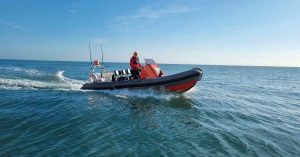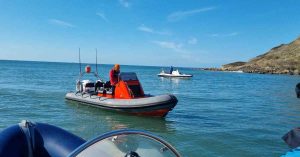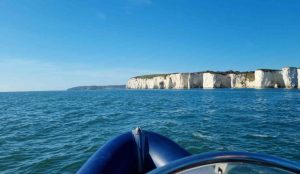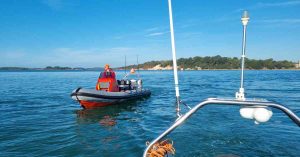Lulworth Trip
Lulworth by Boat from Poole – Autumn 2025

We know from talking to our students that many of you want to make the trip to Lulworth by boat but this is a trip that requires careful planning. It’s a trip we have undertaken many times but not one for beginners as lots to think about. Last week we found a good weather window, support from others and our two boats were recently serviced and ready to go so we thought we’d share our thoughts on things to think about. We don’t want to put people off but its important to recognise this is trip for experienced boat handlers who understand navigation and safety situations as well as boat handling.
Experience Level
We know that being on the water is not all about qualifications. Time on the water is important as that is where people learn. However ‘bits of paper’ do give us a measure. It is a careful balance between pushing the comfort levels but not too far! Blissful ignorance is a dangerous thing! Experience is a personal measure that only you can determine. Turning our attention to qualifications in the Powerboat Scheme, the PB2 is really aimed at trips of up to 3 miles, local day time trips.
By the time people move onto the Intermediate scheme they should already have theory knowledge to the level of Day Skipper Theory and lots of time on the water. The Intermediate Course looks at making passages along the coast. However, we should bear in mind that our coastline is very different. Heading to the Solent from Poole is very different to heading to Weymouth. It is important any skipper has a good understanding of not only the theory of tidal races, but also sea survival and handling boats in rougher conditions. This comes with experience not necessarily just qualifications. By the time a Skipper achieves the Advanced qualifications they should be more than capable of determining the conditions for making this run.
Planning
Before getting to a passage plan, keep an eye on the weather to identify a good window. We knew the week was looking good so narrowed it down to the best day looking at weather and tide. We had light North Westerly winds and tide was favourable. As the evenings start to draw in we wanted to ensure good visibility and to be back before fading light. We weren’t fixed on a set day and instead had flexibility to react.
Next step in the planning was identifying accompanying boats or people to make the trip to Lulworth by boat together. We could have simply made the trip on one of our boats. The boats are serviced and maintained, full of fuel but that leaves us with little contingency if anything goes wrong. Cars break down even when serviced so it is reasonable to assume this can on occasion happen to boats. The coastline is not forgiving in the event of a breakdown due to overfalls, a rocky shore and deep water.
Going in company gives us back up to at least tow away from danger whilst resolving an issue. We planned to take both our RIBs but contacted an experienced friend to accompany us on the second boat for another pair of hands. He asked if another friend could join with their boat. We know him well enough to know he would only have suggested another capable boat and skipper. That gave us three boats and five skippers, all very experienced and with recently serviced boats. Travelling in company is not only potentially safer but also enjoyable.
Travel Companions
Choose your travelling companions well. We knew four of the people and knew that the fifth person was well known to the others who we trusted. He had someone we knew on board which left us confident that we could have a fun trip without worrying about unsafe high jinks. We all know about impact injuries and waves and are all old enough to have aches and pains we don’t want to make worse! The trip would be no fun if you were worrying about someone acting dangerously. This was meant to be a relaxed and enjoyable trip.
We knew we were all happy to act independently. There was no silly close quarter high speed passes, no wake jumping and everyone was respected to travel at their own pace. Just an occasional glance to make sure we were all still visible. Amongst us we had instructors, commercial skippers, ex Navy and ex RNLI crew. We have all completed first aid courses, sea survival, navigation and VHF radio as a min alongside boat handling. We are not saying you need all these qualifications, just an awareness of the reassurance this gives us.
Equipment
Check your boat is kitted out before coastal trips. In our case both RIBs are used for training and commercial work so we had little extra to add. We did ensure we had plenty of fuel for a longer trip and took a slightly more enhanced tool kit for repairs if needed – realistically gaffer tape and cable ties provide a lot of temporary fixes! A trip to Lulworth by boat from Poole does require some extra planning than a simple trip to Studland. In terms of personal kit, a quick check upon meeting showed that everyone had hats, sun cream, full waterproofs, spare layers etc.
I’m not sure exactly how many handheld VHF radios we had! By chance we all had at least one each plus a fixed radio on each boat! On this occasion not everyone had a PLB and its something to think about potentially adding. We weren’t unduly worried on this occasion due to the people involved, number of boats and daylight calm weather trip. Every person on the trip could have handled a MOB situation, first aid or radio calls. Don’t forget food, although there was no posh picnic, we all had spare snacks and plenty of water.
Passage plan
This isn’t a blog to go into detail on how to make a passage plan but suffice to say that each skipper should make their own. The complexity of it will depend on experience and local knowledge but be aware of a few specifics on route to Lulworth. Think about the tidal races at Old Harry/Handfast Point, Peveril Ledge, Durlston Head/Anvil Point and at St Albans Ledge. Check your contour lines and check out potential hazards on route such as rocks and wrecks. We chose to stop at Chapmans Pool on route which gave us chance to catch up, take a break and reassess the ranges.
Its helpful to have looked at position in terms of Lat/Long for the ranges in advance and checked where on board you can monitor this. In our case, the inner range was operating and we’d spoken to the ranges both before leaving by phone and then by VHF radio on route. We were given a clearance of being south of 35′ and were clearly being monitored by the range boats on route. We were probably quite identifiable as a group of three.
Consider what equipment you have on board for how much detail you need in terms of bearings, distance and speed time distance calculations. In our case three boats, 5 mobile phones, each with at least two navigation apps (!), hand bearing and fixed compasses…. but we still had a paper plan in case and screenshot to our phones. Our port of refuge as we headed down the coast changed with a view that Weymouth or Portland would be easier than returning if assistance needed. In addition to electronics we also carry paper charts.
Radio Checks & NCI
It is worth calling NCI on route, not only for a radio check but as they are the eyes and ears along the coats logging each boat as it passes. We had a slight issue with one radio so it was useful to call a specific NCI station to check range of communication. Reassuring to receive a message on our Facebook page that we’d been spotted, listened to and logged on route! We are very lucky in this area to have numerous NCI stations.
Trip
It turned out to be the perfect day for the trip. We had a slight delay in the morning getting organised but took this time to ensure the boats were ready. We knew we still had sufficient time to be through and return with favourable tides and weather. Out of Poole Harbour, speed limits now relaxed in the main channels but don’t forget no excessive wash & safe speed still applies. The 10 knot speed limit is also in place for the section between Bell and just past Channel 8 buoy. We met up with the third boat, pleasantries exchanged and off past Old Harry. The boats separated a little through Swanage with one boats choosing to go inshore around the bay and the others cutting straight across.
Swanage NCI are always a reassuring sight as we pass Peveril point on route to Durlston and Anvil Point. The sea through all three sections was nice and calm with a slight swell running as we all explored the coastline around Dancing Ledge and the caves on route. No specific birdlife to report but one day I will get to see the Puffins! On this occasion it was lots of walkers and rock climbers to watch. Next stop was round St Albans Head. It was smooth water but with a definite swell running through which the boats made light work of.
Next stop Chapmans Pool for a water stop and catch up. Impressed to see people still swimming! Quick chat with the range boat and next we headed South to the point agreed and then Westwards past the firing range. Finally, a line into Lulworth Cove. Interesting spectator sport watching the range boat chasing boats who hadn’t responded to calls over the radio.

Return
The return route scooted round the ranges and then straight back. The tide was starting to run and definitely more swell than the run out particularly around St Albans and Peveril. Much harder to take videos and photos as we needed to hold on but no craziness and the boats handled it easily. All in all a good day out. None of the boats missed a beat which was great. Surprisingly fuel bill not too bad and everyone enjoyed the day.
Learning points
Every day is a learning day…what might we do differently? Checking who had PLBs earlier in the trip, entering the third boats MMSI number into our phone books although we had, at least, pre agreed a VHF channel. Extra suggestions we have for you – ensure each boat knows the skipper is responsible for their own boat and decisions. Know when to bail out and check the weather carefully. Make sure you are sufficiently experienced before attempting this trip and consider travelling in company.













